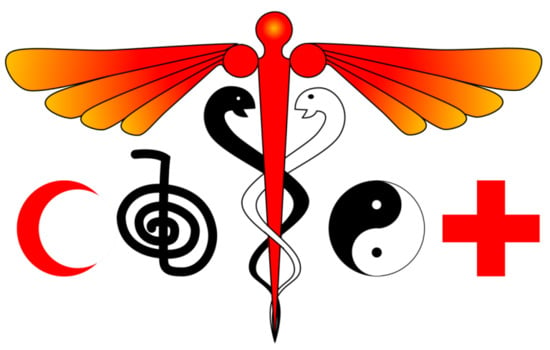Connecting West and East
Abstract
:1. The Fundamentals of Western Medicine
2. The Fundamentals of Eastern Medicine
3. The Limitations of Western Medicine
4. The Limitations of Eastern medicine
5. How to Connect Western and Eastern Medicine
Author Contributions
Funding
Conflicts of Interest
Abbreviations
| TCM | Traditional Chinese Medicine |
References
- Van der Greef, J.; van Wietmarschen, H.; Schroën, J.; Wang, M.; Hankemeier, T.; Xu, G. Systems biology-based diagnostic principles as pillars of the bridge between Chinese and Western medicine. Planta Med. 2010, 76, 2036–2047. [Google Scholar] [CrossRef]
- Schroën, Y.; van Wietmarschen, H.A.; Wang, M.; van Wijk, E.P.; Hankemeier, T.; Xu, G.; van der Greef, J. East is East and West is West, and never the twain shall meet. Science 2014, 346, S10–S12. [Google Scholar]
- World Heath Organization. Global Strategy and Plan of Action on Public Health, Innovation and Intellectual Property; WHO Press: Geneva, Switzerland, 2011. [Google Scholar]
- Bast, A.; Haenen, G.R. Ten misconceptions about antioxidants. Trends Pharmacol. Sci. 2013, 34, 430–436. [Google Scholar] [CrossRef] [PubMed]
- Kim, E.J.; Chen, Y.; Huang, J.Q.; Li, K.M.; Razmovski-Naumovski, V.; Poon, J.; Chan, K.; Roufogalis, B.D.; McLachlan, A.J.; Mo, S.-L. Evidence-based toxicity evaluation and scheduling of Chinese herbal medicines. J. Ethnopharmacol. 2013, 146, 40–61. [Google Scholar] [CrossRef] [PubMed]
- Rang, H.P.; Ritter, J.M.; Flower, R.J.; Henderson, G. Rang & Dale’s Pharmacology; Elsevier Health Sciences: London, UK, 2014. [Google Scholar]
- Alberts, B.; Bray, D.; Hopkin, K.; Johnson, A.D.; Lewis, J.; Raff, M.; Roberts, K.; Walter, P. Essential Cell Biology; Garland Science: New York, NY, USA, 2013. [Google Scholar]
- Weseler, A.R.; Ruijters, E.J.; Drittij-Reijnders, M.-J.; Reesink, K.D.; Haenen, G.R.; Bast, A. Pleiotropic benefit of monomeric and oligomeric flavanols on vascular health-a randomized controlled clinical pilot study. PLos ONE 2011, 6, e28460. [Google Scholar] [CrossRef]
- Hooper, L.; Kay, C.; Abdelhamid, A.; Kroon, P.A.; Cohn, J.S.; Rimm, E.B.; Cassidy, A. Effects of chocolate, cocoa, and flavan-3-ols on cardiovascular health: a systematic review and meta-analysis of randomized trials. Am. J. Clin. Nutr. 2012, 95, 740–751. [Google Scholar] [CrossRef] [PubMed] [Green Version]
- Tang, W.; Eisenbrand, G. Chinese Drugs of Plant Origin: Chemistry, Pharmacology, and Use in Traditional and Modern Medicine; Springer Science & Business Media: Heidelberg, Germany, 2013. [Google Scholar]
- Zhang, M.; Vrolijk, M.; Haenen, G. The Screening of Anticholinergic Accumulation by Traditional Chinese Medicine. Int. J. Mol. Sci. 2017, 19, 18. [Google Scholar] [CrossRef]
- Tao, W.; Xu, X.; Wang, X.; Li, B.; Wang, Y.; Li, Y.; Yang, L. Network pharmacology-based prediction of the active ingredients and potential targets of Chinese herbal Radix Curcumae formula for application to cardiovascular disease. J. Ethnopharmacol. 2013, 145, 1–10. [Google Scholar] [CrossRef] [PubMed]
- van Wietmarschen, H.A.; van der Greef, J.; Schroën, Y.; Wang, M. Evaluation of symptom, clinical chemistry and metabolomics profiles during Rehmannia six formula (R6) treatment: an integrated and personalized data analysis approach. J. Ethnopharmacol. 2013, 150, 851–859. [Google Scholar] [CrossRef] [PubMed]
- Jóźwiak-Bebenista, M.; Nowak, J.Z. Paracetamol: mechanism of action, applications and safety concern. Acta Pol. Pharm. 2014, 71, 11–23. [Google Scholar] [PubMed]
- Croft, S.L.; Sundar, S.; Fairlamb, A.H. Drug resistance in leishmaniasis. Clin. Microbiol. Rev. 2006, 19, 111–126. [Google Scholar] [CrossRef] [PubMed]
- Haldar, K.; Bhattacharjee, S.; Safeukui, I. Drug resistance in Plasmodium. Nat. Rev. Microbiol. 2018, 16, 156. [Google Scholar] [CrossRef]
- Vrolijk, M.F.; Opperhuizen, A.; Jansen, E.H.; Bast, A.; Haenen, G.R. Anticholinergic accumulation: A slumbering interaction between drugs and food supplements. Basic Clin. Pharmacol. Toxicol. 2015, 117, 427–432. [Google Scholar] [CrossRef] [PubMed]
- Ioannidis, J.P. Why most clinical research is not useful. PLoS Med. 2016, 13, e1002049. [Google Scholar] [CrossRef] [PubMed]
- Friedman, H.H.; Fireworker, R.B.; Nagel, H. Biasing Research: Can Science be Trusted? J. Leadersh. Account. Ethics 2017, 14, 105–116. [Google Scholar]
- Singh, I. Bad boys, good mothers, and the “miracle” of Ritalin. Sci. Context 2002, 15, 577–603. [Google Scholar] [CrossRef]
- Bierly, P.; Chakrabarti, A. Generic knowledge strategies in the US pharmaceutical industry. Strateg. Manag. J. 1996, 17, 123–135. [Google Scholar] [CrossRef]
- Hong, H. Principles of Chinese Medicine: A Modern Interpretation; World Scientific: London, UK, 2015. [Google Scholar]
- van der Greef, J.; van Wietmarschen, H.; Schroën, Y.; Babouraj, N.; Trousselard, M. Systematic approaches to evaluation and integration of eastern and Western medical practices. Med. Acupunct. 2015, 27, 384–395. [Google Scholar] [CrossRef]
- Zhang, M.; Schiffers, P.; Janssen, G.; Vrolijk, M.; Vangrieken, P.; Haenen, G.R. The cardiovascular side effects of Ma Huang due to its use in isolation in the Western world. Eur. J. Integr. Med. 2018, 18, 18–22. [Google Scholar] [CrossRef]
- Yao, Y.; Zhang, X.; Wang, Z.; Zheng, C.; Li, P.; Huang, C.; Tao, W.; Xiao, W.; Wang, Y.; Huang, L. Deciphering the combination principles of Traditional Chinese Medicine from a systems pharmacology perspective based on Ma-huang Decoction. J. Ethnopharmacol. 2013, 150, 619–638. [Google Scholar] [CrossRef]
- Pipe, A. Efficacy and safety of ephedra and ephedrine for weight loss and athletic performance. Clin. J. Sport Med. 2004, 14, 188–189. [Google Scholar] [CrossRef] [PubMed]
- Zhang, M.; Moalin, M.; Vervoort, L.; Li, Z.W.; Wu, W.B.; Haenen, G. Connecting Western and Eastern Medicine from an Energy Perspective. Int. J. Mol. Sci. 2019, 20, 1512. [Google Scholar] [CrossRef] [PubMed]
- Rosch, P.J. Bioelectromagnetic and subtle energy medicine. Ann. N. Y. Acad. Sci. 2009, 1172, 297–311. [Google Scholar] [CrossRef] [PubMed]




© 2019 by the authors. Licensee MDPI, Basel, Switzerland. This article is an open access article distributed under the terms and conditions of the Creative Commons Attribution (CC BY) license (http://creativecommons.org/licenses/by/4.0/).
Share and Cite
Zhang, M.; Moalin, M.; Haenen, G.R.M.M. Connecting West and East. Int. J. Mol. Sci. 2019, 20, 2333. https://doi.org/10.3390/ijms20092333
Zhang M, Moalin M, Haenen GRMM. Connecting West and East. International Journal of Molecular Sciences. 2019; 20(9):2333. https://doi.org/10.3390/ijms20092333
Chicago/Turabian StyleZhang, Ming, Mohamed Moalin, and Guido R.M.M. Haenen. 2019. "Connecting West and East" International Journal of Molecular Sciences 20, no. 9: 2333. https://doi.org/10.3390/ijms20092333
APA StyleZhang, M., Moalin, M., & Haenen, G. R. M. M. (2019). Connecting West and East. International Journal of Molecular Sciences, 20(9), 2333. https://doi.org/10.3390/ijms20092333






